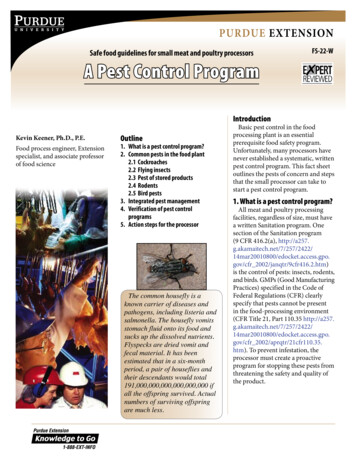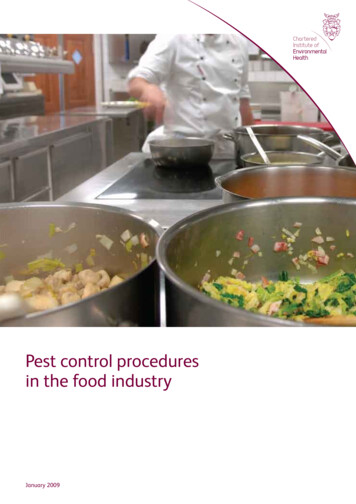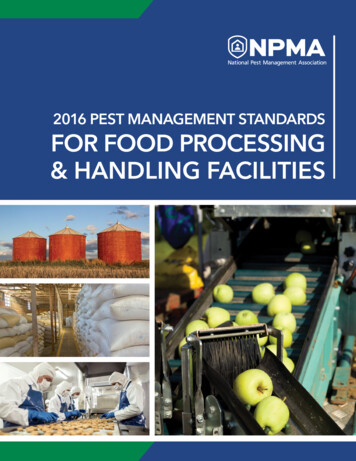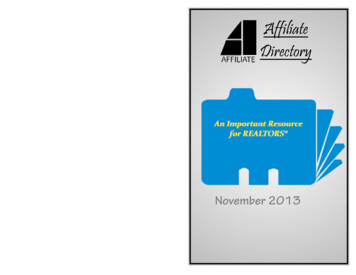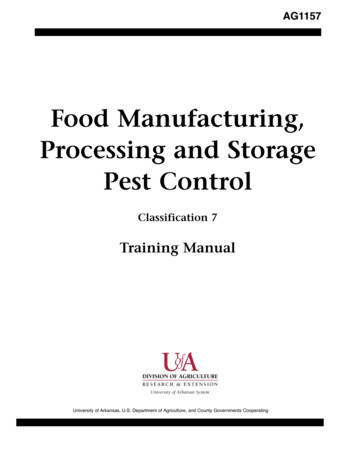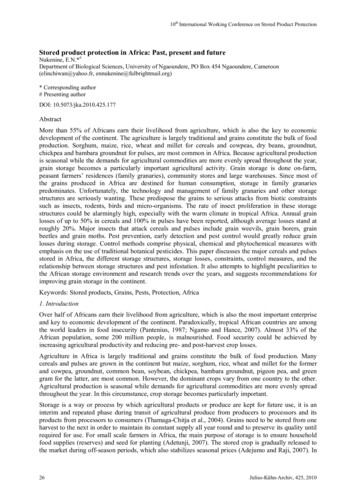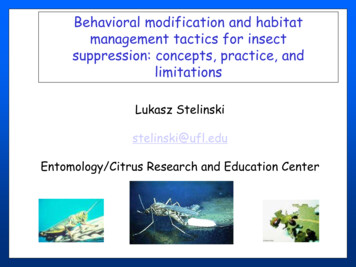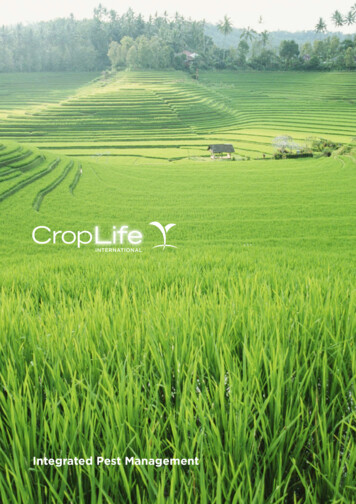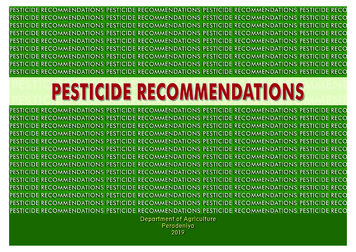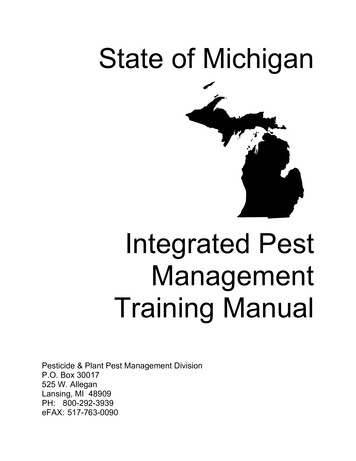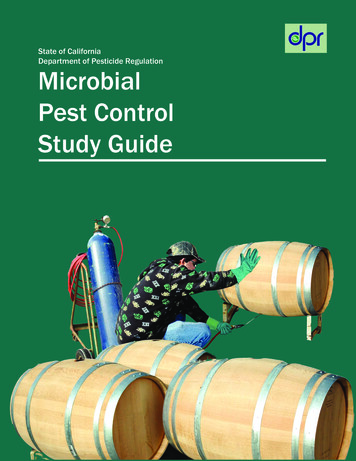
Transcription
State of CaliforniaDepartment of Pesticide RegulationMicrobialPest ControlStudy Guide
This publication resulted from a contractbetween the Pest Management and Licensing Branch of theDepartment of Pesticide RegulationandPatrick J. O’Connor-Marer, Ph.D., Roseville, CA.Writer, Editor, and DesignerPatrick J. O’Connor-MarerPrincipal Pest Management and LicensingCoordinator and EditorAdolfo R. Gallo
State of CaliforniaEdmund G. Brown, Jr.GovernorLinda S. AdamsSecretary for Environmental ProtectionMary-Ann WarmerdamDirectorCalifornia Department of Pesticide RegulationThis guide was published by theCalifornia Department of Pesticide RegulationPest Management and Licensing BranchLicensing and Certification Program1001 I Street, P.O. Box 4015Sacramento, CA 95812-4015Phone: For additional copies or more information, contactthe Licensing and Certification Programat the above address, phone number, email address,or web address.Any part of this study guide may be reproduced or distributedwithout permission for any BUT profit-making purposes.DPR Publication Number 647(Est. 01/2011)i
TECHNICAL ADVISORY COMMITTEEThe following people participated on the Microbial Pest Control Advisory Committee andserved as key resources for specific subject matter areas. They developed the knowledge expectations and performance objectives that became the basis for this manualand the DPR certification examination in the Microbial Pest Control category. Theyprovided up-to-date technical information as well as ideas and helpful suggestionsfor this manual and they reviewed various manuscript drafts. They also participatedin the development and review of the Microbial Pest Control examination item pool.John CooledgeNapa County Department ofAgriculture. Napa, CADavid HenryTrinchero Family EstatesSt Helena, CAJim CrandellWoodbridge Winery/ConstellationWines US, Woodbridge, CARoy HiroseDPR Enforcement BranchSacramento, CAAdolfo GalloDPR Pest Management and LicensingBranch, Sacramento, CAChris SavageE&J Gallo WineryModesto, CAVince GuiseContra Costa County Department ofAgriculture, Concord, CAJames TakahashiConstellation Wine TechnicalServicesc/o Robert Mondavi WineryOakville, CAJulian HaleszConcannon VineyardLivermore, CAJohn YarboroughDelicato Family VineyardsManteca and King City, CASpecial thanks to the following people who recruited Advisory Committee members,participated in committee meetings, or set up photographs for this manual.Ignacio Cruz-OsorioDelicato Family VineyardsKing City, CATim SchmelzerCalifornia Wine InstituteSacramento, CALuis D’AmbrosioThe Wine GroupModesto, CASteve SylvesterE&J Gallo WineryModesto, CAGarry DeVoreE&J Gallo WineryModesto, CAJohn YarboroughDelicato Family VineyardsManteca and King City, CALuis NavaDelicato Family VineyardsKing City, CAThanks also to the following reviewers from the Department of Pesticide Regulation.Vic AcostaLaurie BrajkovichDavid DuncanMargie ReadAda Ann Scottii
TABLE OF CONTENTSIntroduction — 1Chapter 1 – Using Antimicrobial Pesticides — 3Important Considerations — 4Types of Microbial Pest Control — 4Review Questions — 6Chapter 2 – Microbial Organisms — 7Bacteria — 7How Bacteria Spread — 8Fungi — 8How Fungi Spread — 8Algae — 8Viruses — 9Slimes and Biofilms — 9Review Questions — 10Chapter 3 – Controlling Microbial Organisms — 13Exclusion — 13Sanitation — 13Modifying the Environment — 13Irradiation — 14Chemical Control — 14Review Questions — 15Chapter 4 – What are Pesticides? — 17Antimicrobial Pesticide Toxicity — 18Measuring Pesticide Toxicity — 18Lethal Dose and Lethal Concentration — 19No Observable Effect Level — 19Threshold Limit Value — 19Factors That Influence Pesticide Toxicity — 20Pesticide Toxicity Classification — 20DANGER/POISON and DANGER Pesticides — 21WARNING Pesticides — 21CAUTION Pesticides — 21Pesticide Formulations — 22Selecting a Formulation — 22Review Questions — 23Chapter 5 – Pesticide Laws and Regulations — 25Employer Requirements — 26TABLE OF CONTENTSiii
Pesticide Product Labeling — 26Supplemental Labels — 26When to Read the Pesticide Label and Attached Bookletsor Other “Pull-Off” Labeling — 26Material Safety Data Sheets — 27Pesticide Use Records — 27Monthly Summary Pesticide Use Reports (Non-ProductionAgricultural Sites) — 28Federal Restricted-Use Pesticides and California RestrictedMaterials — 29Employee Training — 29Using Pesticides Safely — 29The Pesticide Label — 29Pesticide Containers — 29Mixing and Application Equipment — 30Making a Pesticide Application — 30Handling and Cleaning Application Equipment — 30Health Effects — 30Skin Exposure — 30Eye Exposure — 31Respiratory Exposure — 31Oral Exposure — 31Pesticide Illness or Injury — 31Symptoms of Pesticide Exposure — 32Avoiding Exposure — 32Personal Protective Equipment — 32Heat-Related Illness — 33Pesticide Emergencies — 33First Aid for Skin Exposure — 35First Aid for Eye Exposure — 35First Aid for Inhaled Pesticides — 36First Aid for Swallowed Pesticides — 36Disposing of Contaminated Clothing and Other ContaminatedItems — 36Employee Rights — 37Non-Compliance — 37Review Questions — 38Chapter 6 – Handling Antimicrobial Pesticides — 41Handle Containers Carefully — 41Personal Protective Equipment — 41Minimal Protective Clothing — 42Disposable Protective Clothing — 42Gloves — 42ivTABLE OF CONTENTS
Footwear — 42Eye Protection — 42Respiratory Protection Equipment — 42Transporting and Storing Pesticides — 43Transporting — 43Storage — 44Review Questions — 45Chapter 7 – Emergency or Incident Response — 47Cleaning Up Pesticide Leaks or Spills — 47Clear the Area — 47Wear Personal Protective Equipment — 48Contain the Leak — 48Clean Up the Pesticide — 48Clean Nonporous Surfaces and Safety Equipment — 48Dispose of the Material — 48Review Questions —49Chapter 8 – Sanitizing Wooden Wine Barrels and Wine BottleCorks — 51Fumigating Wine Barrels with Sulfur Dioxide Gas — 52Prewash Barrels — 52Read the Pesticide Label — 52Personal Protective Equipment — 53Respiratory Protection — 53Supplied Air Respirator — 53Self Contained Supplied Air Respirator — 54SO2 Monitoring — 54Fumigation Process — 55Fumigating Wine Bottle Corks — 55Avoiding Hazards Associated with Sulfur Dioxide Fumigation — 56SO2 Cylinders — 56Working with SO2 Gas — 56Review Questions — 57Chapter 9 – Microorganism Control in Water CoolingSystems — 59Closed Recirculating Systems — 59Once-Through Systems — 60Open Recirculating Systems — 60Problems Associated with Water Cooling Towers — 60Scale Deposits — 60Corrosion — 60Fouling — 61Wood Decay — 61TABLE OF CONTENTSv
Microbial Growth — 61Algae — 61Fungi — 61Bacteria — 61Water Treatment — 61Methods of Application — 62Hazards — 62Review Questions — 63Chapter 10 – Disinfecting Potable Water Lines — 65Preventing Contamination — 65Storing Pipes and Fittings — 65Installing Water Lines — 65Repairing Damaged Water Lines — 66Methods for Disinfecting Water Lines — 66Tablet or Granule Method — 66Calcium Hypochlorite Granules — 66Calcium Hypochlorite Tablets — 66Continuous Feed Chlorination — 66Slug Method — 67Monitoring Chlorine Concentration — 67Final Flushing — 68Bacteriological Testing — 68Avoiding Hazards and Potential Problems — 68Chlorine Compounds — 68Damage to Pipes — 69Protecting People — 69Improper Testing — 69Disposing of Water Flushed From the System — 69Review Questions — 70Review Question Answers — 71Appendix 1 — 72Exemptions for Antimicrobial AgentsAppendix 2 — 73Performance Objectives and Knowledge Expectations for Applying AntimicrobialPesticidesAppendix 3 — 78Employee Handler Training RequirementsAppendix 4 — 81Minimum Required Personal Protective EquipmentGlossary — 83Index — 90viTABLE OF CONTENTS
IntroductionMicroorganisms are very small living or non-living organisms, such asfungi, bacteria, and viruses. Most raw agricultural commodities, otherunprocessed foods, water, and all decaying matter contain some types ofmicroorganisms. Microorganisms occur on the skin and in intestinal tracts of peopleand animals. Under normal conditions, many microorganisms are beneficial andperform useful and necessary functions. In industry, for example, fungi and bacteriahave important uses in manufacturing processes such as the production of organicacids. Some fungi have indispensable roles in the fermentation processes requiredfor making wine, bread baking, cheese making, and brewing beer and other alcoholicbeverages. Some types of intestinal bacteria help people and animals digest particularfoods into usable nutrients.Certain other microorganisms, however, are harmful or dangerous. Shouldconditions become favorable for these microorganisms to grow, they may cause illnesses or diseases in people and animals, produce odors or stains, clog or damageequipment, or contaminate food and beverage products.As part of your duties where you work, you may need to apply substancesknown as antimicrobial pesticides to suppress or destroy troublesome microorganismsin order to protect people from illness, prevent contamination of food or beverages,or prevent damage to equipment and other items.INTRODUCTION1
This study guide covers antimicrobial pesticide uses in the following areas: wine barrels and wine bottle corks water cooling systems potable water systemsIn the U.S., pesticide products are highly regulated chemicals because theyrequire proper handling to prevent them from harming people or the environment.In general, if you apply antimicrobial pesticides for hire in California, you must possess a pest control business license issued by the California Department of PesticideRegulation (DPR). Employers in California are exempt from certain Department ofPesticide Regulation regulatory requirements concerning the use of antimicrobialagents when antimicrobial agents are used only as sanitizers, disinfectants, and pooland spa chemicals, and as long as they follow corresponding Department of Industrial Relations regulatory requirements in Title 8, California Code of Regulations (8CCR). See Appendix 1—Exemptions for Antimicrobial Agents on page 72 for a list ofthe corresponding regulations.Each pest control business main and branch location must designate a personresponsible for the pest control activities conducted by that business location. Thatincludes assuring that non-certified pesticide handler employees are supervised bya certified applicator, either the responsible QAL or any other company certified applicator. The responsible person must possess a valid Qualified Applicator License(QAL) in the Microbial Pest Control category (Category P). Other pesticide handlersworking from that location can obtain a Qualified Applicator Certificate (QAC) in theMicrobial Pest Control Category P. Both are considered commercial pesticide applicatorcertifications, but only a person with the QAL can be designated as the responsibleperson for a pest control business main and branch locations. One advantage ofhandler employees being certified applicators is that the employer does not have toprovide pesticide safety training to certified applicators.To earn the QAL in Category P or the QAC in Category P, you will need todemonstrate your competence in handling and using pesticides safely. This involvespassing two written examinations: one on pesticide laws and regulations and basicprinciples, and another on microbial pest control. This manual will help you preparefor the QAL and QAC microbial pest control exams. To prepare for the laws andregulations exam, study the Laws and Regulations Study Guide available from DPR. Youmay download a copy from DPR’s website or you may purchase a printed copy ofthis publication from DPR by using the Video/Publication Order Form. The links to thestudy guide and order form are located on the Licensing and Certification Programweb site at http://www.cdpr.ca.gov.To review what knowledge and skills you are expected to have in order tosuccessfully pass the Microbial Pest Control certification examination, read Appendix 2—Performance Objectives and Knowledge Expectations for Applying AntimicrobialPesticides, on page 73.Chapters 1 through 7 of this manual cover general information that is pertinentto anyone using antimicrobial pesticides in any occupational setting. Each of theremaining chapters cover information specific to particular occupational settings.Be sure to read and answer the review questions at the end of each of the chapters.These questions are similar in format and content to the actual examination questions.Answering these questions will help you become familiar with the Microbial PestControl Licensing/Certification Examination and will improve your understandingof the information presented in this manual. After answering the questions at theend of each chapter, check your answers by referring to the answer sheet on page 71.Note: Many of the important and/or unfamiliar terms in this study guide have been italicized the firsttime they appear in the text. Turn to the Glossary on page 83 for more detailed definitions of these terms.In other instances, some terms are italicized for emphasis.22INTRODUCTION
1Using AntimicrobialPesticidesAntimicrobial pesticide products contain one or more of about 300 differentactive ingredients. Manufacturers market these in several formulations suchas sprays, liquids, concentrated powders, and gases. The U.S. EnvironmentalProtection Agency (U.S. EPA) maintains a list of current, registered pesticides thatincludes more than eight thousand antimicrobial products. However, nearly half ofthese are public health products, used to control microorganisms that are infectiousto humans. The DPR Microbial Pest Control category does not include antimicrobialpesticide uses covered by the Health Related Pest Control category (Category K). Instead,this category covers all of the non-health related uses of these materials. Category Kincludes the use of pesticides in official programs for the management and controlof pests having medical and public health importance.The DPR licensing/certification Category P spans several occupational settings.Unlike other DPR licensing/certification categories, these various occupational settings generally have no relationship to each other except for the use of antimicrobialpesticides.Normally, if you are responsible for controlling microbial pests in the settingsunder pest control Category P as part of your employment, you most likely spendmost of your time on other job duties that probably have nothing to do with managing microbial pests. The common expectations when using antimicrobial pesticidesare to handle and use them carefully and responsibly to prevent accidents and avoidinjuries to yourself and others.About one-third of the pesticide illnesses reported annually in California are associated withantimicrobial pesticide use. Most of these reportedillnesses or injuries involve individuals who actuallyapply these pesticides. Examples of such illnessesor injuries include accidentally splashing materialsinto the eyes, developing a rash or burn on unprotected skin from caustic substances, or sufferingrespiratory problems by inhaling vapors from anantimicrobial product. In some cases, repeatedover-exposure to certain antimicrobial pesticidesmay cause chronic health problems.Learning the pesticide handling, application,safety, and emergency methods described in thismanual helps you protect yourself, other employees, the public, and the environmentfrom hazards associated with improper antimicrobial pesticide use. This manualprovides the important information you need to know in order to handle and applythese materials legally.USING ANTIMICROBIAL PESTICIDES3
IMPORTANT CONSIDERATIONSWhen using hazardous chemicals such as antimicrobial pesticides, you assume responsibility for the safety ofyourself and others. The purpose of the DPR licensing/certification process is to make sure you understandhazards and know how to avoid health and environmental problems. Some of the knowledge and skills youneed to acquire in order to work safely with antimicrobialpesticides include: following all applicable pesticide laws and regulations as well as DPR-mandated workplace safety requirements ensuring that you consider all health and safety hazards before making anantimicrobial pesticide application, including safety gear and decontamination requirements, and selecting the right pesticide for the job knowing how to prevent people and animals from contacting the pesticidesduring and after application recognizing how some pesticides can damage treated surfaces and how toprevent this knowing how to prepare and maintain records of training and applications knowing how to keep pesticides from drifting or moving out of the area during application knowing what to do and where and how to get help in case of an emergency knowing the procedures for notifying people about the pesticide applicationand procedures for posting the treated area, if necessary, after making anapplicationTYPES OF MICROBIAL PEST CONTROLAlthough people apply microbial pest control chemicals in many different situations, you will likely be involved in only one of these. This manual discusses severaloccupational areas that involve using microbial pest control pesticides. Several additional situations may be included in future versions, but this manual currently covers:Wooden Wine Barrels and WineBottle Corks. Wine production includesaging batches of wine in wooden barrelsbefore bottling. Cleaning and sanitizingthe barrels before using reduces the number of microorganisms that could disruptthe aging process, impart undesirableflavors to the wine, or cause spoilage.Water Cooling Systems. Buildings,such as schools, hospitals, auditoriums, offices, stadiums, and other similar enclosed facilities rely on large water cooling towersto remove heat from air conditioning systems to maintain comfortable temperaturelevels. In addition, cooling towers are used outside in settings such as wineries, forexample, for process cooling. System maintenance may include applying antimicrobialpesticides to the cooling water to prevent disease transmission and suppress algaland fungal growths and slimes that damage the equipment or reduce its efficiency.4USING ANTIMICROBIAL PESTICIDES
Potable Water Systems. Water supplies to commercial and institutional buildings and facilities risk contamination by dangerous disease-causing microorganismswhile these structures are constructed, undergoing repairs, or if the pipes becomedamaged. Sanitizing these water pipes makes them suitable and safe for potable waterby destroying the harmful microorganisms.Before using antimicrobial pesticides, become familiar with the different types ofmicroorganisms to be controlled that occur in your work setting. The following chapter describes bacteria, fungi, algae, viruses, slimes, and biofilms. Chapter 3 reviewsboth chemical and non chemical methods of controlling harmful microorganisms.Other chapters cover specific information about safely using antimicrobial pesticides.USING ANTIMICROBIAL PESTICIDES5
REVIEW QUESTIONS1.When using antimicrobial pesticides, you are expected to alwaysA. Wear waterproof protective clothingB. Handle them carefully and responsiblyC. Follow application instructions on the MSDSD. Report application details to Cal/OSHA2.The main purpose for following safe application methods is to avoidA. Having to work overtimeB. Being fired by your employerC. Endangering yourself, others, and the environmentD. Causing your employer to incur fines3.About what percentage of pesticide related illnesses and injuries reported annually in California involve antimicrobial pesticides?A. 10%B. 25%C. 33%D. 40%4.An important skill you need to develop when applying antimicrobial pesticidesis knowing how toA. Safely operate a motor vehicleB. Design special pesticide application equipmentC. Adjust the amount of pesticide to use to reduce costsD. Keep pesticides from drifting or moving out of the area during applicationTurn to Page 71 for Review Question Answers6USING ANTIMICROBIAL PESTICIDES
2Microbial OrganismsProblem-causing microbial organisms (also known as microorganisms) includebacteria, fungi, algae, and viruses. It is often necessary to have the microorganism identified in order to apply the appropriate control. However, their smallsize complicates identification. Proper identification usually requires the expertise ofa specialist. Most of these organisms are so small that scientists must use powerfulmicroscopes to see them. They may also carry out certain chemical tests to confirmtheir identity. For example, they may grow an organism in the laboratory or injectit into plants or laboratory animals so they can analyze the results for a positiveidentification.Usually, specific types of microorganisms are more prevalent in particularlocations or under certain environmental conditions. Therefore, the location andenvironmental conditions of a site may aid in identification. In addition, fungi oftenproduce unique structures such as molds or spore-producing bodies that can help toidentify them. Some types of microorganisms are highly resistant to chemicals andmany tolerate adverse environmental conditions, which contributes to the difficultyin controlling them.BACTERIABacteria are microscopic, one-celled organisms. Theyreproduce in two different ways: by dividing to become twoidentical cells, a process known as fission, or by producing a sporethat later develops into a new cell. Bacteria that form spores aredifficult to control because spores are extremely resistant to heat, chemicals,and drying. Some bacteria can reproduce by fission as often as once every 15 to 30minutes. Under ideal conditions, a single bacterium could become 70 billion bacteriain only 12 hours.Scientists usually classify bacteria by their shape and theway they absorb special stains. Bacteria assume one of threeshapes: spherical, rod-shaped, or spiral-shaped. If they turna violet color when treated with a material called the Gramstain, they are “Gram-positive” bacteria. If they do not stainthis color, they are “Gram-negative” bacteria.Bacteria cause damage in one of two ways. Some produce toxins that are poisonous to other living organisms. These toxins may cause illness, paralysis, or death.Other bacteria produce enzymes that dissolve living cells or cause undesirable changesin nonliving materials such as adhesives and plastics. Sometimes these enzymescontaminate food or equipment or cause a buildup of material on surfaces of objects.MICROBIAL ORGANISMS7
How Bacteria SpreadAnything that moves and comes in contact with bacteria or bacterial spores canspread them to other areas. This includes air (bacterial spores), water, equipment,rodents and other animals, insects, and people. Unlike viruses, bacteria can surviveoff their hosts for relatively long periods.FUNGIFungi are a large group of non-green plants that live by feeding on eitherliving or dead organisms. They cannot make their own food because, like bacteria, they lack the green plant pigment, chlorophyll. Some fungi, such as yeasts,are tiny single-celled organisms. Others, such as mushrooms, are multicelled andbecome very large. Fungi and bacteria often occur together in nature.Fungi reproduce in several different ways. Some multiplyfrom cell fragments. Others produce spores that function like plantseeds. Many species of fungi produce more than one type of spore.Some act as resting structures to carry the fungus through adverse conditions, while others are responsible for the ongoing secondary spreadof the organism. Spores of fungi are not as resistant to chemicals, heat,or drying, as are bacterial spores.Although many fungi are beneficial in breaking down organic matter and for making bread, cheese, wine, and beer, some types cause diseases inhumans, other animals, and plants. Ringworm, for example, is a fungal infectionof the skin or nails. Serious forms of fungal disease include coccidioidomycosis(a disease of the respiratory system accompanied by fever and skin eruptions)and histoplasmosis (a disease affecting the lungs, spleen, and central nervoussystem). Several types of fungi cause decay and mildew of wood, fabrics, andpaper products.Fungi that invade water cooling towers and similar structures have avegetative body, called the mycelium, that is composed of tiny filaments calledhyphae. The mycelium grows through the fibers of wooden portions of thecooling equipment. This structure is usually large enough to be visible withoutmagnification.Characteristics of the mycelium and fruiting bodies aid specialists in identifying fungi. Fruiting bodies are the structures that produce spores, so finding thesestructures in damaged wood confirms a fungal infection.How Fungi SpreadSpores of fungi spread by air, water, insects, and any practice that moves theinfected host from one location to another. A fungal organism requires certain environmental conditions to begin to grow and infect objects. These conditions ofteninclude high humidity or presence of water and warm temperatures.ALGAEAlgae are primitive plants closely related to some fungi andprotozoans. They differ in that they contain chlorophyll and otherpigments. Algae reproduce by means of spores, cell division, orfragmentation. They range from microscopic single-celled organisms to 200 foot-long seaweeds. Algae occur in fresh and salt waterand on land. There are more than 17,000 identified species of algae.8MICROBIAL ORGANISMS
Color and structure are important features when identifying and classifyingtypes of algae. Colors include blue-green, brown, red, and green. Structural types ofpest algae include planktonic, filamentous, and attached-erect. Microscopic algae impartgreenish or reddish colors to water. They also may form a scum that floats on thewater surface. Filamentous algae form dense free-floating or attached mats. Attachederect algae, known as Chara and Nitella, resemble flowering plants. This is becausethey have leaf-like and stem-like structures.Algae are important food sources for many organisms, including people, buthave little medical importance to people or livestock. However, algae give drinkingwater disagreeable tastes or odors, clog water filtering systems and water coolingtowers, foul ponds, pools, waterways, and underwater structures, and interfere withcertain operations that use large quantities of water. Large algal blooms will causefish death because algae deplete oxygen in the water. Some forms of decomposingalgae release toxins into water, which may be poisonous to people or livestock.VIRUSESViruses are extremely small organisms that reproduce inside living cells. Controversy exists on whether these are actually living organisms. Most can only survivefor short periods outside a host plant cell or animal cell. Viruses alter chemical activitywithin host cells and these changes often cause disease.Viruses are so small that specialists must use an electron microscope to observe or study them. They have different shapesdepending on the type. Structurally, viruses are very simplecompared with other living organisms. When viruses invadeliving cells, they use their own genetic information to alter thesecells, so the cells produce more viruses rather than their usualproteins or nucleic acid.Viruses spread through the air, water, bodily fluids, tissues, and by contaminated equipment.SLIMES AND BIOFILMSSlimes are combinations of fungi, algae, bacteria, and other organisms. Biofilmsare a particular type of slime. Slime and biofilm organisms grow onto or penetratesurfaces and produce adhesive substances that make removal difficult. Slimes andbiofilms also grow inside empty wooden wine barrels. They can be troublesomein water and sewage systems because they clog pipes. They affect the efficiency ofwater cooling towers and are pests in certain paper mill operations. They attach tothe metal surfaces of gas and oil pipelines and wellheads and cause substantial corrosion problems.MICROBIAL ORGANISMS9
REVIEW QUESTIONS1.Why is it sometimes necessary to have a microorganism identified by anexpert before trying to control it?A. Proper identification is mandated by the pesticide labelB. To avoid suppressing beneficial microorganismsC. To comply with federal lawD. To select the most effective control method2.BacteriaA. Are multicelled organismsB. Produce the green pigment chlorophyllC. Can be spread by anything that contacts themD. Are the cause of histoplasmosis3.Fruiting bodies aid in the identification ofA. BacteriaB. FungiC. VirusesD. All microorganisms4.The vegetative bodies produced by fungi and composed of tiny filaments arecalledA. SporesB. MyceliumC. HyphaeD. Fruiting bodies5.Environmental conditions that are ideal for fungal infection includeA. Warm temperatures and moistureB. Cold temperatures and moistureC. Warm temperatures and dry conditionsD. Cold temperatures and dry conditions6.Algae areA. A combination of fungi and bacteriaB. Closely related to some bacteriaC. Primitive plantsD. Single celled organisms only10MICROBIAL ORGANISMS
7.VirusesA. Are multicelled organismsB. Reproduce inside living cellsC. Are identified using Gram stainsD. Can survive for long periods outside plant or animal cells8.Combinations of fungi, bacteria, algae, and other organisms createA. LichenB. Dense matsC. CharaD. SlimesTurn to Page 71 for Review Question AnswersMICROBIAL ORGANISMS11
12MICROBIAL ORGANISMS
3Controlling MicrobialOrganismsMethods for controlling microorganisms include chemical (antimicrobialpesticides) and non chemical approaches. Antimicrobial pesticides eitherdestroy the microorganisms or provide barriers that exclude them from anarea. Sometimes antimicrobials inhibit the growth of microorganisms. Non chemicalmethods include exclusion and sanitation, and may also involve modifying the environment to regulate temperature and moisture. Other methods, such
Water Treatment — 61 Methods of Application — 62 Hazards — 62 Review Questions — 63 . regulations exam, study the Laws and Regulations Study Guide available from DPR. . may purchase a printed copy of this publication from DPR by using the Video/Publication Order Form. The links to the s
